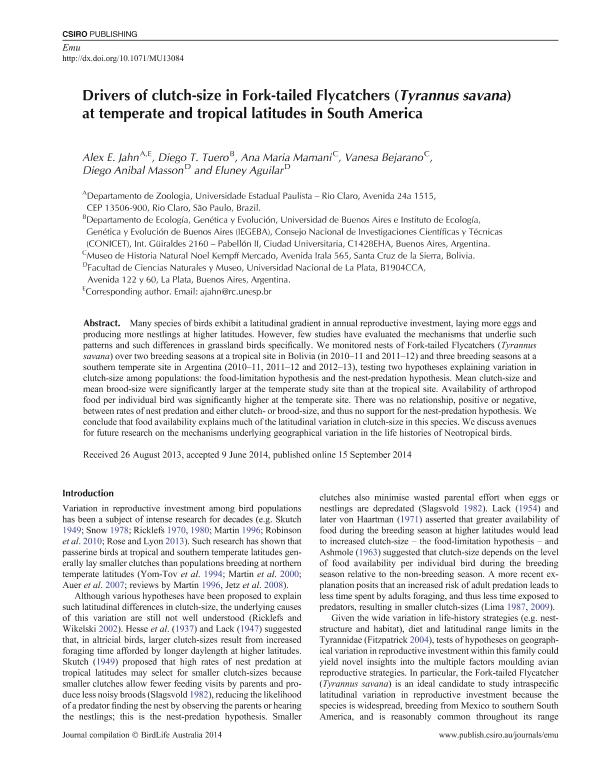Artículo
Drivers of clutch-size in Fork-tailed Flycatchers (Tyrannus savana) at temperate and tropical latitudes in South America
Jahn, Alex; Tuero, Diego Tomas ; Mamani, Ana Maria; Bejarano, Vanesa; Masson, Diego Anibal; Aguilar, Eluney
; Mamani, Ana Maria; Bejarano, Vanesa; Masson, Diego Anibal; Aguilar, Eluney
 ; Mamani, Ana Maria; Bejarano, Vanesa; Masson, Diego Anibal; Aguilar, Eluney
; Mamani, Ana Maria; Bejarano, Vanesa; Masson, Diego Anibal; Aguilar, Eluney
Fecha de publicación:
09/2014
Editorial:
Csiro Publishing
Revista:
Emu
ISSN:
0158-4197
Idioma:
Inglés
Tipo de recurso:
Artículo publicado
Clasificación temática:
Resumen
Many species of birds exhibit a latitudinal gradient in annual reproductive investment, laying more eggs and producing more nestlings at higher latitudes. However, few studies have evaluated the mechanisms that underlie such patterns and such differences in grassland birds specifically. We monitored nests of Fork-tailed Flycatchers (Tyrannus savana) over two breeding seasons at a tropical site in Bolivia (in 2010-11 and 2011-12) and three breeding seasons at a southern temperate site in Argentina (2010-11, 2011-12 and 2012-13), testing two hypotheses explaining variation in clutch-size among populations: the food-limitation hypothesis and the nest-predation hypothesis. Mean clutch-size and mean brood-size were significantly larger at the temperate study site than at the tropical site. Availability of arthropod food per individual bird was significantly higher at the temperate site. There was no relationship, positive or negative, between rates of nest predation and either clutch- or brood-size, and thus no support for the nest-predation hypothesis. We conclude that food availability explains much of the latitudinal variation in clutch-size in this species. We discuss avenues for future research on the mechanisms underlying geographical variation in the life histories of Neotropical birds.
Palabras clave:
HISTORIA DE VIDA
,
TAMANO DE PUESTA
,
TYRANNUS SAVANA
,
TIJERETA
Archivos asociados
Licencia
Identificadores
Colecciones
Articulos(IEGEBA)
Articulos de INSTITUTO DE ECOLOGIA, GENETICA Y EVOLUCION DE BS. AS
Articulos de INSTITUTO DE ECOLOGIA, GENETICA Y EVOLUCION DE BS. AS
Citación
Jahn, Alex; Tuero, Diego Tomas; Mamani, Ana Maria; Bejarano, Vanesa; Masson, Diego Anibal; et al.; Drivers of clutch-size in Fork-tailed Flycatchers (Tyrannus savana) at temperate and tropical latitudes in South America; Csiro Publishing; Emu; 114; 4; 9-2014; 337-342
Compartir
Altmétricas



